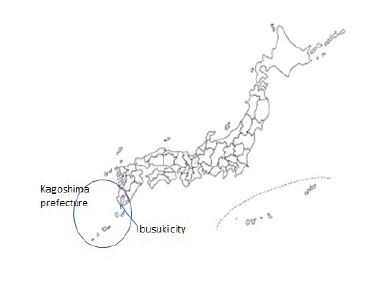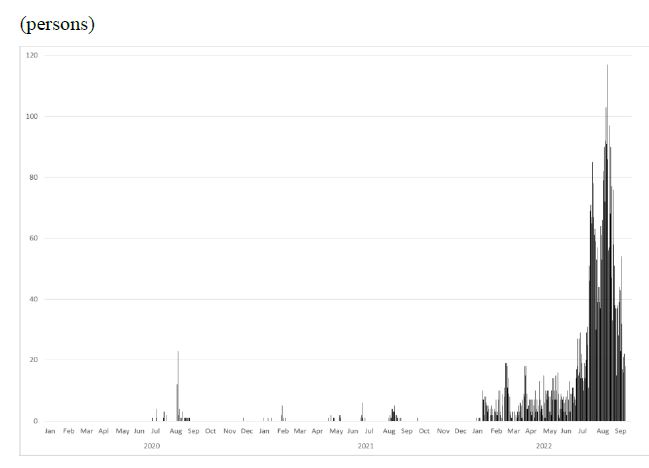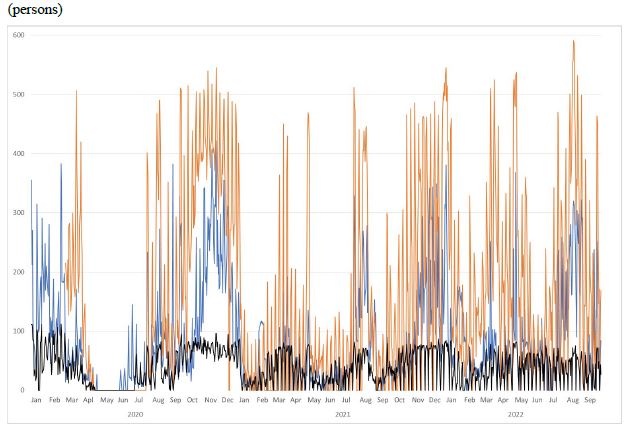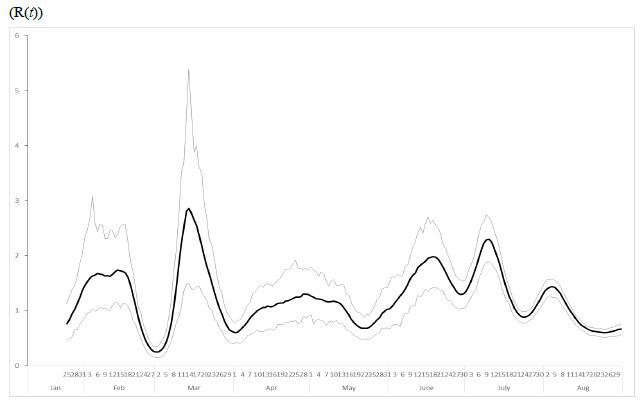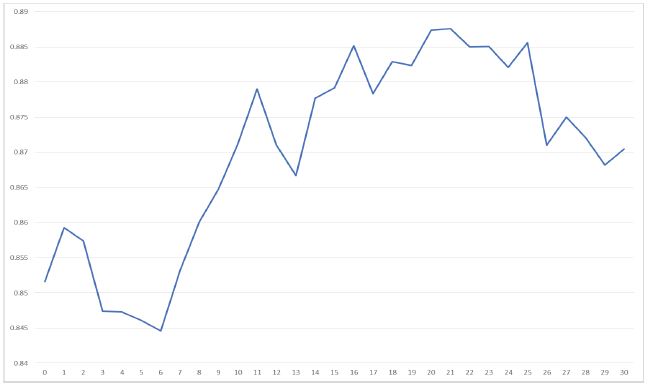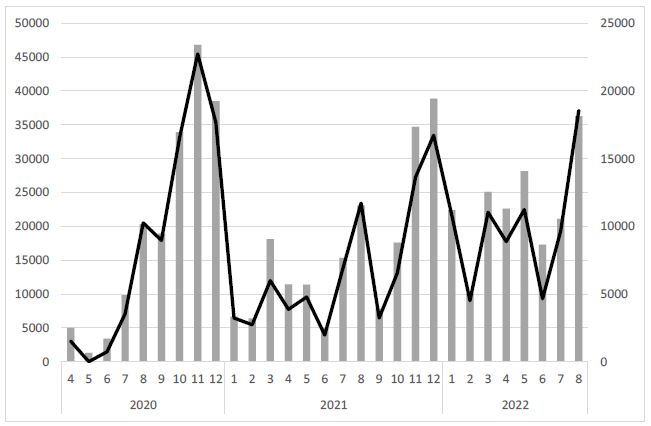Journal Name: Journal of Health Science and Development
Article Type: Research
Received date: 16 May, 2023
Accepted date: 16 June, 2023
Published date: 2024-02-01
Citation: Iwasaki Y, Ohkusa Y, Kurita J (2023) Association of Sightseeing Tourists and COVID-19 Outbreak: A Case Study of a Hot Spring Resort. J Health Sci Dev Vol: 6, Issue: 1 (08-16).
Copyright: Iwasaki Y et al. This is an open-access article distributed under the terms of the Creative Commons Attribution License, which permits unrestricted use, distribution, and reproduction in any medium, provided the original author and source are credited.
Abstract
Background: Long-distance travel for sightseeing, which was believed to have spread the COVID-19 outbreak, was banned until 2022. Nevertheless, no report has described a detailed examination of that belief and policy.
Object: This study was conducted to confirm the effects of long distance travel on infectivity at a hot spring resort.
Methods: We used a unique dataset including the daily numbers of visitors at three major hotels in Ibusuki city to evaluate how sightseeing tourism affected the COVID-19 effective reproduction number and newly confirmed patients. Study periods were January 25 through August 31, 2022 for the effective reproduction number and from August 19, 2020 through September 20, 2022 for newly confirmed patients.
Results: Neither measure of infectivity was found to be significantly associated with tourism, as represented by hotel visitors.
Discussion and Conclusion: Estimation results demonstrated that sightseeing tourists might not have affected the COVID-19 outbreak.
Keywords:
COVID-19, Hotel visitors, Hot spring resort, Effective reproduction number, Sightseeing tourism.
Abstract
Background: Long-distance travel for sightseeing, which was believed to have spread the COVID-19 outbreak, was banned until 2022. Nevertheless, no report has described a detailed examination of that belief and policy.
Object: This study was conducted to confirm the effects of long distance travel on infectivity at a hot spring resort.
Methods: We used a unique dataset including the daily numbers of visitors at three major hotels in Ibusuki city to evaluate how sightseeing tourism affected the COVID-19 effective reproduction number and newly confirmed patients. Study periods were January 25 through August 31, 2022 for the effective reproduction number and from August 19, 2020 through September 20, 2022 for newly confirmed patients.
Results: Neither measure of infectivity was found to be significantly associated with tourism, as represented by hotel visitors.
Discussion and Conclusion: Estimation results demonstrated that sightseeing tourists might not have affected the COVID-19 outbreak.
Keywords:
COVID-19, Hotel visitors, Hot spring resort, Effective reproduction number, Sightseeing tourism.
Introduction
Policies administered by governments should be evaluated ex post facto as well as ex ante. However, such official evaluations are rare in Japan because governments are postured as never making mistakes. Countermeasures against the COVID-19 outbreak have never been evaluated ex post because, during the pandemic, little knowledge and experience about COVID-19 were available. Ex ante evaluation was too difficult and imprecise. That lack of ex ante evaluation notwithstanding, ex post evaluation has also been rare. For example, long-distance travel for sightseeing was believed to spread outbreaks. In fact, such travel was banned until 2022. At least one study advocated this public stance, but it was found to include numerous mistakes and was discounted as evidence and as a basis for policy. It was refuted and contradicted completely [1,2].
Another study found contrasting evidence that the effective reproduction number was significantly lower during the period when long distance travel was promoted [3]. Moreover, another study showed that airport users at a local airport were associated with reduced infectivity [4]. These findings might be strong evidence casting doubt on the legitimacy and rationality of policies banning long-distance travel. However, these studies specifically examined large areas. In fact, the former study examined the entirety of Japan. The latter assessed a prefecture, and the original strain. In general, the study areas were larger, suggesting greater difficulty in identifying people engaged in long-distance tourism. The eventual analyses might be more indirect. Moreover, the mutated strain was well known to have had higher infectivity than the original strain [5,6]. Indeed, some probability exists that long distance travel affects the infectivity of the mutated strain differently than it affects the infectivity of the original strain. Studies must analyze tourism in much smaller areas and must include a period during which the mutated strain was dominant.
Therefore, this study was conducted to confirm longdistance travel effects on infectivity at a hot spring resort. Specifically, we examined Ibusuki city in Kagoshima prefecture, as shown in figure 1. That city of about 37.7 thousand residents has a famous hot spring and several sightseeing spots. Collaboration among epidemiologists and major hotels in Ibusuki city facilitated deeper analyses to examine the object of this study. Especially, data of the daily number of hotel visitors at three major hotels in Ibusuki city are extremely useful. Official published data have been monthly or annual data. Consequently, the association between sightseeing tourism and infectivity has not been analyzed using readily available, published data. The unique collaboration which was possible for this study enabled us to approach this study objective precisely.
As a countermeasure against the COVID-19 outbreak in Japan, school closure and voluntary event cancellation were required from February 27 ,2020 through the end of March ,2020. Large commercial events were also cancelled. Subsequently, a state of emergency was declared on April 7 through 25 May, entailing voluntary restrictions against going out, and the shuttering of businesses that personally served customers. During this period, the first peak of infection was reached on April 3. The next peak occurred on July 29, as shown in figure 2. However, even though the so-called “Go To Travel Campaign” (GTTC) might have expanded the outbreak, it commenced on July 22, 2020. The GTTC program, which was aimed at supporting tourism businesses, subsidized 50% of travel expenses with coupons issued for shopping at tourist destinations. The GTTC continued through December, by which time the third wave had been reached. The third wave was larger than either of the prior two waves in December. Therefore, GTTC was inferred as the main reason for the third wave [7].
Figure 1:Map of Kagoshima prefecture and Ibusuki city.
However, although results were mixed, results of some earlier studies have suggested that COVID-19 might be associated with climate conditions, at least in China [8- 10]. Another study using a cross-sectional international comparison among European countries found no association among climate conditions and COVID-19 outbreak surge dates [11]. If the association were confirmed for Japan, then GTTC might not be inferred as the main reason for the third wave in winter.
Actually, mobility was inferred as the main cause of the outbreak dynamics, at least in the first wave in Japan and worldwide [12,13]. One study found that nonpharmaceutical interventions including lockdowns strongly affected transmission reduction, at least in 11 European countries through April [14]. Another study of 131 countries found that the introduction and relaxation of lockdowns or movement restrictions had limited effects on infectiousness, except for public event bans, although their data were limited to the end of July, 2021 [15]. One study of Argentina showed that strict movement restrictions imposed from March were effective at reducing mobility but not at mitigating the outbreak. These mixed results suggest that those countermeasures might not strongly affect mobility [16].
However, how the numbers of sightseeing visitors or long-distance travelers themselves affect outbreak situations in rural areas has not been described well in reports of the relevant literature. Actually, we searched literature in PubMed using the search terms of “COVID-19,” “resort,” and “tourist,” identifying only 10 reports of studies (accessed June 9, 2023). Of those, only one study examined an association among resorts and the outbreak situation [17]. Its comparison of resort areas and non-resort areas during GTTC in Japan revealed that the rate of increase in the number of patients was greater in non-resort areas than in resort areas. However, no putative association among the number of visitors and outbreaks was investigated.
The reason for the apparent lack of such studies is that such information might be less available for epidemiological analysis. Little if any annual or monthly data related to travelling and sightseeing might be available. Such data would be too aggregated, thereby leaving too few data points to apply statistical analyses for a short period of less than one year. To support the present study, collaboration among epidemiologists, statisticians, and companies managing resort hotels and buses to airports has been achieved in rural areas, with daily data of bus users from the airport and visitors at these hotels. Therefore, the hypothesis that sightseeing visitors and long-distance travelers spread the COVID-19 outbreak in rural areas can be tested directly. This hypothesis was the rationale for policies banning long-distance travel during the first and second states of emergency or during cessation of the GTTC, although they have not been analyzed or confirmed to date.
Figure 2:Map of Kagoshima prefecture and Ibusuki city.
Methods
Unique data including the daily numbers of hotel visitors at three major hotels in Ibusuki city were provided for analyses. These sales data of each hotel were provided voluntarily to assess the association among hotel visitors and outbreaks of COVID-19.
The outbreak activity was measured by the daily number of newly confirmed patients, including asymptomatic patients, in Ibusuki city [18]. In general, the outbreak situation was expressed as R(t). Therefore, the procedure for calculating R(t) was the same as that used for earlier studies [2-4]. However, if the population is small, then the effective reproduction number cannot be estimated or cannot be estimated steadily because its denominator (the number of patients who can infect others, as weighted by their infectivity) was very small or sometimes zero. Even in the case of Ibusuki city, the data were too volatile before January 25, 2022. In other words, analyses using the effective reproduction number could not be performed for GTTC or the original, or Alpha or Delta variant strains. However, analyses using newly confirmed patients were feasible, even for study periods including no patients. Moreover, because of data unavailability in the future period, the effective reproduction number during the last 20 days of the study period was incomplete and unstable. For that reason, we also omitted data of the effective the reproduction number in September 2022.
The period from infection to reporting was presumed to be several days. It includes the incubation period, the period from onset to visiting a doctor, testing, and reporting. In general, reporting would lag several days after infection. In light of that fact, we regressed the number of newly confirmed patients with some lag on the number of tourists as well as other potentially explanatory variables. Then, we sought the best-fitted lag measured by the adjusted determinant coefficient over a 0−30-day delay. The value of R(t) was adjusted for these lags. Therefore, these lags need not be considered for analyses in which R(t) was the dependent variable.
The study period for analyses conducted with newly confirmed patients was defined as August 19, 2020, through September 20, 2022, when the report from Ibusuki city listed the last detected initial case in Ibusuki city. After this period, information about COVID-19 patients in Ibusuki city has not been available.
We use some variables as explanatory variables. First, the number of tourists to Ibusuki city was inferred as the number of visitors at three major hotels in Ibusuki city.
Figure 3:Hotel visitors at three hotels in Ibusuki city.
Note: Data for a hotel represented by the orange line had been shown since March 2020, but data of the other two hotels had started in January 2020 because
of data availability at the hotel.
Average temperature and relative humidity data for Kagoshima prefecture were used as climate conditions. Temperatures were measured in degrees Celsius. We obtained Japan Meteorological Agency data (https://www. data.jma.go.jp/gmd/risk/obsdl/index.php).
Additionally, we identified several remarkable countermeasures in Japan taken during the study period: three of four state-of-emergency declarations and the GTTC. The second state of emergency was declared on January 7, 2021 for the 11 most-affected prefectures. This countermeasure mandated restaurant closure at 8:00 p.m., with voluntary restrictions against going out, but school closure was not required. That declared state continued through March 21, 2021. The third and fourth state-ofemergency declarations were put into effect from April 24 through June 20, 2021 (third) and from July 12 through September, 2021. During the fourth declared state of emergency, the Olympic Games were held in Tokyo from July 22 through August 8, 2021. We also regard the Olympic Games as a potentially infectivity-affecting event.
To clarify associations and R(t) or newly confirmed patients and sightseeing tourists, in addition to climate, mobility, and countermeasures, we used ordinary least squares regression to regress the daily R(t) or newly confirmed patients on data for the number of daily hotel visitors at three hotels, as well as daily climate, mobility, vaccine coverage, the proportions of the mutated strains, and dummy variables assigned to countermeasures. For mobility, we used Google-provided mobility data reflecting the presence of people at six venues: restaurants, shopping malls and amusement areas; grocery stores and pharmacies; parks; transition areas; workplaces; and homes (https:// www.google.com/covid19/mobility/). Those data reflect mobility compared to the baseline, which is the median value, for the corresponding day of the week, during the 5-week period of January 3 – February 6, 2020. A number of 100 was defined is assigned if the number of persons staying at a type of venue was the same as the baseline.
We expected the sign of the explanatory variables to be the following: hotel visitors at three major hotels or GTTC increased infectivity if the policy of banning long distance travel was rational. State-of-emergency countermeasures were presumed to decrease infectivity if they were applied conscientiously. Moreover, the vaccine coverage was expected to reduce infectivity. By contrast, mutated strains such as the Omicron variant strain, particularly its B.5 its sublineage, had higher infectivity than the original or earlier mutated strains [5,6,19-22]. We adopted 5% as the significance level.
Ethical considerations
Information about patients used for this study was collected under the Law of Infection Control of Japan. It was published in newspapers every day [18]. Three hotels provided business recorded data voluntarily. Data for the visitors to three hotels included no personal or private information. Therefore, no ethical issue is posed by this study.
Results
Figure 2 presents newly confirmed cases of COVID-19, including asymptomatic cases, through September 20, 2022 in Ibusuki city. The initial case was detected on July 1, 2020. However, cases were sporadic until 2022. From January 2022, the cases were reported continuously, exhibiting the largest peak in August when Omicron BA.5 variant strain was dominant. Therefore, we limited these analyses to the association of R(t) and tourism after January 25, 2022.
Figure 4 presents R(t), as estimated from January 25 through August, 2021. The highest peak was recorded in March, when the dominant lineage of BA.1 was replaced by BA.2. The second and third peaks occurred respectively in June and July, when the BA.2 and BA.5 lineages dominated.
Figure 5 shows the adjusted determinant coefficients with several delays using newly confirmed patients as dependent variables. The findings indicate a 25-day delay as the best fitted. Therefore, hereinafter, the dependent variable was the number of newly confirmed patients with a 25-day delay.
Table 1 shows that tourism was not associated with R(t) and as newly confirmed with a 25-day delay. Therefore, no evidence can be found to support some rationale for a longdistance travel ban policy.
Increased temperature, humidity, and visits to restaurants increased R(t). By contrast, coverage of the fourth vaccination decreased it. Regarding the newly confirmed patients, going to groceries and pharmacies, coverage of the second to fourth vaccination, the proportion of BA.5 sublineage of the Omicron variant strain, the fourth state of emergency, and the Olympic Games extended the outbreak. By contrast, the proportion of the Delta variant strain and BA.1 and BA.2 sublineages of the Omicron variant strain suppressed the outbreak. Results related to vaccine coverage and newly confirmed patients were unexpected. Results related to the proportion of the Delta variant strain and BA.1 and BA.2 sublineages of the Omicron variant strain coverage and newly confirmed patients suggest that these mutated strains were less infective than the original Wuhan strain, which might be inconsistent with findings obtained from earlier studies [5,6,19-22].
Figure 4:Estimated effective reproduction number and its 95% confidence interval.
Note: Black line represents the estimated effective reproduction number. Gray lines represent its 95% confidence interval. Because the estimated effective
reproduction numbers before January 25, 2022 were sometimes higher than six and unstable, the period before January 25, 2022 was omitted from this
illustration. Because of future data limitations, the effective reproduction number in the last 20 days was incomplete and unstable. Therefore, we also omitted
showing effective reproduction number for September 2022.
Discussion
Estimation results indicated that sightseeing tourists might not increase infectivity and expand the outbreak at all. Findings suggest that the legitimacy and rationale for banning sightseeing and long-distance travel were not supportable. An accompanying study showed that the effective reproduction number in 2022 found for Yakushima, a resort island in Kagoshima prefecture, Japan, was not associated with the number of sightseeing tourists [23]. This study found results consistent with those of that related study.
Some unexpected results were obtained for all vaccine effects on the number of newly confirmed patients, although the result of vaccine effects of the fourth shot to R(t) was negative and significant, as expected. The estimated coefficients of vaccine effects on the newly confirmed patients were 0.18–0.92 because vaccine coverage was measured by percentage as 0–100. Therefore, these estimated coefficients suggest that patients would increase by 18–92 persons if vaccine coverage were increased from no vaccination at all to full coverage. These numbers would be too large for Ibusuki city: in fact, the peak of the epidemic curve in figure 2 was less than 120.
Figure 5:Adjusted determinant coefficients with several delays in newly confirmed patients from March 1, 2020 through April 20, 2022.
Note: Line represents the adjusted determinant coefficients of estimation with newly confirmed patients several days after on the explanatory variables today.
| Effective reproduction number | Newly confirmed patients with 25-day delay | |||
|---|---|---|---|---|
| Explanatory variable | Estimated coefficient | p value | Estimated coefficient | p value |
| Visitors at three hotels | 0.000466 | 0.068 | -8.8E-05 | 0.943 |
| Temperature | 0.039137 | 0.044 | 0.021047 | 0.715 |
| Humidity | 0.009696 | 0.048 | -0.00813 | 0.767 |
| Place: Restaurant, shopping mall or amusement | 0.031125 | 0.028 | -0.10975 | 0.05 |
| Place: Grocery store or pharmacy | -0.01403 | 0.375 | 0.140052 | 0.023 |
| Place: Park | -0.00408 | 0.415 | -0.00054 | 0.982 |
| Place: Transition | 0.007483 | 0.47 | 0.009137 | 0.851 |
| Place: Workplace | 0.021809 | 0.1 | -0.0201 | 0.73 |
| Place: Home | 0.041157 | 0.352 | 0.090826 | 0.696 |
| 2nd state of emergency | -0.15892 | 0.875 | ||
| 3rd state of emergency | -0.42121 | 0.731 | ||
| GTTC | 0.155073 | 0.871 | ||
| 4th state of emergency | 4.496548 | 0.006 | ||
| Olympic | 4.713315 | 0.004 | ||
| Vaccine coverage of the second dose with lag (%) | 0.132773 | 0.63 | 0.316527 | 0 |
| Vaccine coverage of the third dose with lag (%) | -0.02557 | 0.137 | 0.175827 | 0.047 |
| Vaccine coverage of the fourth dose with lag (%) | -0.07184 | 0.001 | 0.915219 | 0.004 |
| Share of Alpha variant strain (%) | -0.00489 | 0.745 | ||
| Share of Delta variant strain (%) | -0.24736 | 0 | ||
| Share of Omicron BA.1 variant strain (%) | -0.01907 | 0.363 | -0.22704 | 0 |
| Share of Omicron BA.2 variant strain (%) | -0.01978 | 0.321 | -0.30101 | 0 |
| Share of Omicron BA.5 variant strain (%) | -0.01456 | 0.478 | 0.372003 | 0 |
| constant | -8.19481 | 0.72 | -0.62761 | 0.744 |
| Adjusted R2 | 0.2186 | 0.8856 | ||
Table 1:Estimation results of association among the estimated reproduction number / newly confirmed with 25 days delay with hotel visitors at three major hotels
in Ibusuki city from August 19, 2020/ January 25, 2022 through August 31, 2022/ September 20, 2022
Note: Yellow marking denotes significance except for constant terms. The estimation period for the effective reproduction number was from January 25 through
August, 2022. The period before January 9, 2022 was omitted because the effective reproduction number was higher than six and too volatile. Because of
anticipated future data limitations, the effective reproduction number in the last 20 days was incomplete and unstable. Therefore, we also omitted this period from
estimation. The estimation period for the newly confirmed patients was March 1 through September 20, 2022.
Major differences existed among two dependent variables of the denominator. The effective reproduction number was controlled by the denominator, although newly confirmed patients were not controlled. In this sense, to measure outbreak activity, the effective reproduction number might be more appropriate than the number of newly confirmed patients, even though data of the number of newly confirmed patients have been used widely [24-26]. However, controlling the denominator prohibits analysis of data before January 25, 2022 because the denominators were too small or zero: the effective reproduction number is either incalculable or unstable. Therefore, the study period for the effective reproduction number must exclude the period during which the original, Alpha and Delta strains were dominant. Only during the period when Omicron was dominant in 2022 was the number of patients large, even in Ibusuki city. The effective reproduction number is calculable and stable. In other words, for analyses before 2022, the effective reproduction number might be inappropriate. The newly confirmed patients were more appropriate for use in considering the effects of sightseeing tourism on the outbreak.
Figure 6:Monthly total numbers of hotel visitors in Ibusuki city and at three hotels.
Note: Bars represent all hotel visitors in Ibusuki city measured by left scale. The line represents hotel visitors to three corporate hotels shown on the right
scale. The correlation coefficient of them from January 2020 through August 2022 was 0.9817; its p value was 0.000.
The weakest point of this study might be the representativeness of using these unique data: daily hotel visitors at three corporate hotels. Unfortunately, no comparable daily data were available. However, comparable monthly data for all hotels in Ibusuki city were available. Figure 6 depicts monthly data of visitors at all hotels in Ibusuki city. The correlation coefficient among them from January 2020 through August 2022 was 0.9817; the p-value was 0.000. Therefore, the three corporate hotels providing daily data presumably reflect the data of other hotels and therefore all hotel visitors to Ibusuki city.
Of course, hotel visitors might include visitors who had a purpose other than sightseeing, such as business or spa therapy. However, for any purpose, hotel visitors might similarly or equally spread the virus in the city. Therefore, our obtained results are expected to be valid for other purposes of hotel visitors.
The present study has some limitations. First, this study specifically examines only Ibusuki city, Kagoshima prefecture. Therefore, it remains uncertain whether the same results are applicable to other places in Japan or to the entirety of Japan.
Second, although three hotel visitors represented other hotels, some visitors might have stayed at friends’ or relatives’ homes. They also might have spread the virus in the city to a similar degree as hotel visitors. If the number of friends’ or relatives’ home stayers was comparable with the number of hotel visitors or more, and if their trend were much different from that of hotel visitors, then estimation results considering them might be different from this study. Unfortunately, we have no information about them. Controlling for their effects is expected to be our next challenge.
Third, results of regression analysis such as those obtained from this study do not indicate causality. Although we inferred that the number of hotel visitors would expand the outbreak, a wider outbreak might increase hotel visitation. One must bear such points in mind when interpreting the results.
Conclusion
Because the numbers of hotel visitors were not significantly correlated with the numbers of newly confirmed patients or effective reproduction numbers, we infer that increased numbers of visitors did not expand the COVID-19 outbreak. Therefore, we conclude that the rationality and fairness of the policy banning long distance travel were weak. We expect to check the robustness of these findings by repeating analyses for other places in Japan.
The present study is based on the authors’ opinions: it does not reflect any stance or policy of their affiliations.
Acknowledgments
We acknowledge the unique data providers as well as the great efforts of all staff at corporate three hotels, public health centers, medical institutions, and other facilities fighting the spread and destruction associated with COVID-19.
Ethical Considerations
All information about patients used for this study was collected under the Law of Infection Control, Japan and published by newspaper [17]. Information related to hotel visitors at corporate hotels was provided voluntarily for analyses. Hotel visitors had no personal or private information. Therefore, no ethical issue is posed by this study.
ICMJE Statement
Contributors JK was responsible for the coordination of the study and analyzed the data. YI set the data. All authors contributed to the writing of the final manuscript.
Competing interest
No author has any conflict of interest, financial or otherwise, to declare in relation to this study.
Anzai A, Nishiura H (2021) “Go To Travel” Campaign and Travel- Associated Coronavirus Disease 2019 Cases: A Descriptive Analysis, July-August 2020. J Clin Med 10: 398. [ Ref ]
Kurita J, Sugawara T, Ohkusa Y (2021) Estimating Event Ban Effects on COVID-19 Outbreak in Japan. Journal of Health Science and Development 4: 19-24. [ Ref ]
Kurita J, Sugawara T, Ohkusa Y (2023) Infectivity of omicron BA.5 comparison with original strain and other mutated strain of SARS-Cov-2 in Japan. Journal of Disaster Research 18: 4-10. [ Ref ]
Kurita J, Iwasaki Y (2022) Did Visitors for Sightseeing Actually Spread COVID-19 Outbreak dominated the original strain in Japan? Ex Post Evaluation for Banning of Long Distance Travel. Jxiv. [ Ref ]
European Centre for Disease Prevention and Control. Epidemiological update: SARS-CoV-2 Omicron sub-lineages BA.4 and BA.5. [ Ref ]
National Institute of Infectious Diseases. Updated Situation of COVID-19 Outbreak (July 13,2022) (in Japanese). [ Ref ]
Japan Times. Politics — not public health — drove Suga U-turn on Go To Travel. [ Ref ]
Shi P, Dong Y, Yan H, Zhao C, Li X, et al. (2020) Impact of temperature on the dynamics of the COVID-19 outbreak in China. Sci Total Environ 728: 138890. [ Ref ]
Tobias A, Molina T (2020) Is temperature reducing the transmission of COVID-19? Environ Res 186: 109553. [ Ref ]
Yao Y, Pan J, Liu Z, Meng X, Wang W, et al. (2020) No association of COVID-19 transmission with temperature or UV radiation in Chinese cities. Eur Respir J 55: 2000517. [ Ref ]
Walrand S (2021) Autumn COVID-19 surge dates in Europe correlated to latitudes, not to temperature-humidity, pointing to vitamin D as contributing factor. Sci Rep volume 11: 1981. [ Ref ]
Kurita J, Sugawara T, Ohkusa Y (2020) Mobility data can reveal the entire COVID1-19 outbreak course in Japan. medrxiv. [ Ref ]
Bergman N, Fishman R (2020) Mobility Reduction and Covid-19 Transmission Rates. medrxiv. [ Ref ]
Flaxman S, Mishra S, Gandy A, Unwin HJT, Mellan TA, et al. (2020) Estimating the effects of non-pharmaceutical interventions on COVID-19 in Europe. Nature 584: 257-261. [ Ref ]
Li Y, Campbell H, Kulkarni D, Harpur A, Nundy M, et al. (2021) The temporal association of introducing and lifting non-pharmaceutical interventions with the time-varying reproduction number (R) of SARSCoV- 2: a modelling study across 131 countries. Lancet Infect Dis 21: 193-202. [ Ref ]
Larrosa JMC (2020) SARS-CoV-2 in Argentina: Lockdown, mobility, and contagion. J Med Virol 93: 2252-2261. [ Ref ]
Uchida M (2021) Changes in Numbers of COVID-19 Cases among Residents of Tourist Resort Areas before and during the “Go To Travel” Campaign: Descriptive Epidemiology in Gunma Prefecture. Jpn J Infect Dis 74: 554-559. [ Ref ]
Minami Nipon Shinbun Co.Ltd. Situation of COVID-19 infection by city. (in Japanese). [ Ref ]
Leung K, Shum MHH, Leung GM, Lam TTY, Wu JT (2021) Early transmissibility assessment of the N501Y mutant strains of SARS-CoV-2 in the United Kingdom, October to November 2020. Euro Surveill 26: 2002106. [ Ref ]
Graham MS, Sudre CH, May A, Antonelli M, Murray B, et al. (2021) Changes in symptomatology, reinfection, and transmissibility associated with the SARS-CoV-2 variant B.1.1.7: an ecological study. Lancet Public Health 6: e335-e345. [ Ref ]
Davies NG, Abbott S, Barnard RC, Jarvis CI, Kucharski AJ, et al. (2021) Estimated transmissibility and impact of SARS-CoV-2 lineage B.1.1.7 in England. Science 372: eabg3055. [ Ref ]
Zhao S, Lou J, Cao L, Zheng H, Chong, et al. (2021) Quantifying the transmission advantage associated with N501Y substitution of SARSCoV- 2 in the UK: an early data-driven analysis. J Travel Med 28: taab011. [ Ref ]
Kurita J, Iwasaki Y (2023) Association of sightseeing tourists and COVID-19 outbreak: A case study of a resort island. Jxiv. [ Ref ]
Harris-McCoy K, Lee VC, Munna C, Kim AA (2021) Evaluation of a Test to Stay Strategy in Transitional Kindergarten Through Grade 12 Schools - Los Angeles County, California, August 16-October 31, 2021. MMWR Morb Mortal Wkly Rep 70: 1773-1777. [ Ref ]
Tang JL, Li LM (2021) Importance of public health tools in emerging infectious diseases. BMJ 375: n2374. [ Ref ]
Fukumoto K, McClean T, Nakagawa K (2021) No causal effect of school closures in Japan on the spread of COVID-19 in spring 2020. Nat Med 27: 2111-2119. [ Ref ]
